In the comments of this post about chemistry sets and science education, gwdonnelly asked:
As a kid I loved playing with tools, fire, magnifying glasses, etc, etc. Along with some mates I made thermite and even had a go at some very small touch powder (could do with more practice at growing crystals there!)...
Anyway, I would like to get my kids into doing experiments in a slightly more controlled, and safe, way - any recommendations on what to get a 4-5 year old started with?
I've made this a new post so that other commenters can chime in with ideas. Here's what I managed to think of:
1: As mentioned in that post, growing crystals, including sugar crystals so you end up with rock candy:

(source: Flickr user futileboy)
2: A chemical garden, a quite different kind of crystal experiment often sold as "Magic Rocks".
3: While you're at it, the cheap-'n'-lazy version of a chemical garden, those little cardboard trees that grow fuzzy crystals:
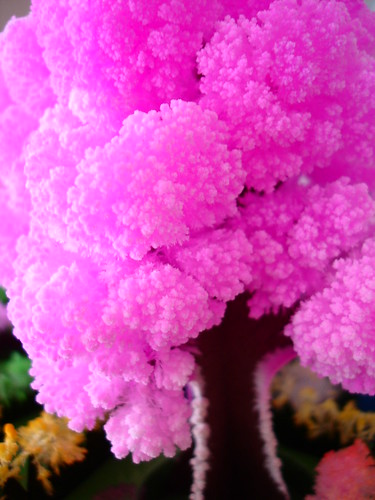
(Source: Flickr user drewish)
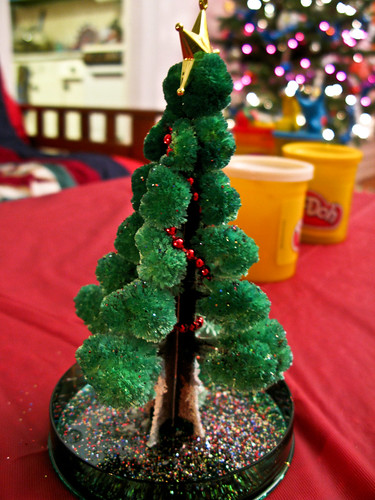
(Source: Flickr user watz)
4: Go for a wander and collect and identify rocks, plants and other people's unattended property. (Strike out whichever does not apply.) You can build a collection of a wide variety of rocks you can't find in your own neighbourhood quite cheaply via eBay, too. Just bear in mind that if a mineral sample seems too good to be true, it's eminently possible that it is.
5: Tumbling your own rocks has been a popular hobby for ages, too; all sorts of ordinary-looking rocks come up lovely when highly polished:
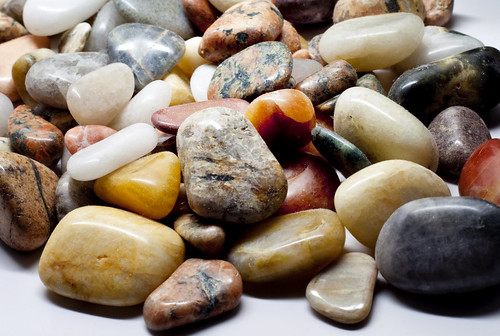
(Source: Flickr user vpickering)
You can make your own tumbler (or "ball mill", which is only a ball mill if you... put balls in it) from a plastic container and a scrounged-up motor. All you're likely to have to buy, besides perhaps a grab bag or two of guaranteed-impressive un-tumbled minerals, is some "tumbling media", so you can have fast abrading of rough stones and fine polishing later on without just hoping a handful of sand will do both jobs. (There are some other inexpensive tumbling-media options, too.)
6: Five years might be a bit young for soldering or an actual microcontroller (look how cheap!), but you can still play with electronics - wires, motors, batteries (and/or a jimmied PC PSU), switches (you've obviously got to have at least one knife switch)...

(Source: Flickr user LenP17)
...breadboards and jumpers and, as I've mentioned before...
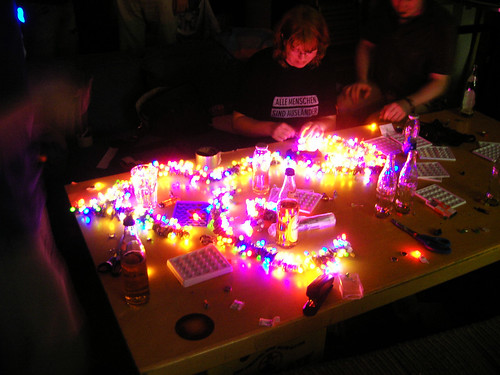
(image source Flickr user c3o)
...a ton of super-cheap LEDs and other components, and surprisingly young kids can build all sorts of things.
7: Make your own thumb piano:

(Source: Flickr user Trocaire)
8: Growing mustard/cress/bean sprouts on a wet paper towel...

(Source: Flickr user kidicarus222)
...or the classic toothpicked spud.
9: Magnets.
Rare-earth magnets are very cheap these days, and small ones make great toys for any kid old enough not to swallow them.
(And even then it's no big deal, unless they swallow more than one. This has recently turned into a problem for people who sell small rare-earth magnets as toys in the USA, because apparently you can't trust an American child under the age of 14 not to eat everything they touch. See also the American Kinder Surprise ban. Apparently something magical happens between the ages of 14 and 18, which transforms American children from Lego-eating lackwits into citizens responsible enough to be trusted with a firearm. But not a beer until they're 21, of course!)
[UPDATE: A less snarky version of the above can be found here. On reflection, I found that the tiny-toy-magnet bans now spreading across the globe are actually quite defensible.]
Do make sure you stick with small rare-earth magnets for toys. Obviously really big rare-earth magnets can crush your hand, but much smaller ones can snap together hard enough that they break. Don't get any very thin ones, and don't get anything with a diameter much more than a centimetre (half an inch, say), and their field is small enough and their momentum low enough that they'll last a long time.
If you want safe big magnets, get simple and cheap black ferrite ones instead; they're much weaker than rare-earth magnets. (It's theoretically possible to lever the big ferrite ring magnet off the back of a speaker driver, but only once have I managed to do that with a magnet of any size without cracking it.)
10: Looking at stuff under a microscope. A proper lab microscope would be best but those sell for pretty large prices, and the cheap small ones for kids are, I think, usually pretty crappy quality. Instead, you could go for one that plugs into a TV:
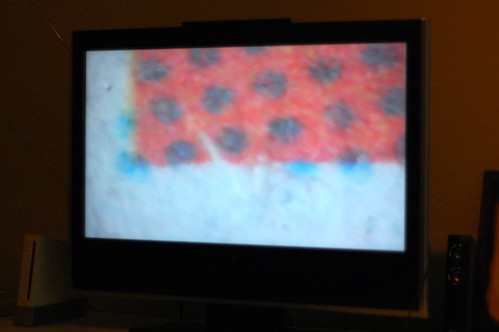
(Source: Flickr user Neven Mrgan)
Everybody seems to like the Eyeclops camera-microscope.
A cheap alternative is, of course, your basic magnifying glass, or a "loupe", which is either a small high-powered magnifying glass, or a monocle-style mad-scientist magnifier.
Or you could buy or make your own Leeuwenhoek glass-bead microscope:
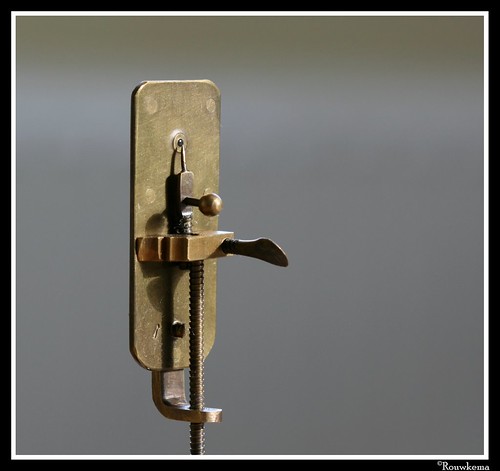
(Source: Flickr user rouwkema)
(One of van Leeuwenhoek's greatest, but least helpful, achievements was concealing how easy it is to make his microscopes' tiny lenses. Everybody thought he ground them with fantastic accuracy, when all he actually did was melt the end of a glass rod and allow surface tension to pull it into a sphere.)
Leeuwenhoek microscopes aren't the easiest to look through, but can effortlessly resolve the tiny beasties in pond water.
Oh, and then there's the quickest microscope ever, provided you have a digital camera with a very small lens, like the camera in a phone: Just put a drop of water on the lens, turn the phone over carefully...
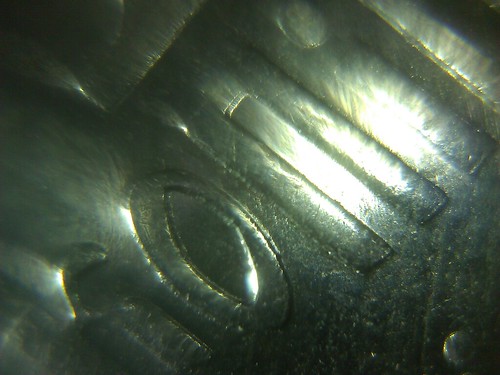
(Source: Flickr user ipasha)
...and bingo, one microscope!
OK, folks; what have I missed?
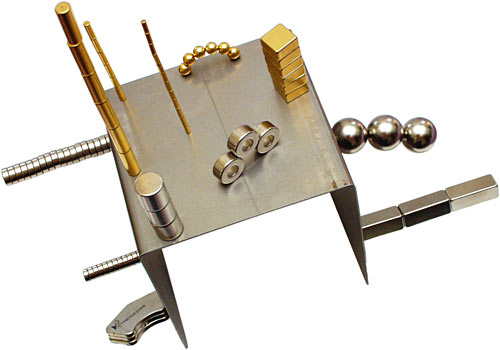
17 August 2012 at 10:08 pm
There's also making hot ice with sodium acetate. I bought a kilo for something like $20. Wifey wasn't too impressed with the containers of vinegary smelling white stuff all over the kitchen for a couple days....
17 August 2012 at 10:58 pm
That magnet recall makes me sad. Seriously, 14? http://tvtropes.org/pmwiki/pmwiki.php/Main/ThinkOfTheChildren
(Hope I'm not making a faux pas by linking to that website. I apologize in advance for people losing the rest of their day.)
-Weasel
18 August 2012 at 2:01 am
LOL...clearly you are not a long time reader. Dan delights in destroying weeks of human productivity by supplying varying pernicious links of interest - TVTropes is just the tip of the iceberg around here!
Welcome the land of the often lost afternoon my friend!
18 August 2012 at 2:55 am
Oh, no, sorry to have given that impression. I've been with Dan since, jeez, must be 8 or 9 years, now, since I started reading middle of my college career, which would place it roughly 2003 or so.
I just know all too well how easily things like this can happen.
-Weasel
18 August 2012 at 1:04 am
On the magnets theme, my kids got a thrill out of playing with a homopolar motor, especially as cracks in the coating of the magnet caused a few sparks to fly.
[Good call! I did a post on homopolar and other home-made motors some years ago. -Dan]
Microscope: I bought my daughter a cheap USB microscope, which she's had a bit of fun with, but we need to find some more stuff to examine with it (was thinking about blades - knives, razors, etc. after reading your post earlier this week).
Also: hot air. A bit old school, perhaps, but I'd like to play with candles, balloons, bottles, eggs, etc. and show how air expands when it's warmer.
18 August 2012 at 3:25 am
Hey, those little round magnets of awesomeness are excellent for all sorts of magnetic fun, if a bit overpriced. The idiotic safety culture of the US, which Dan noted so well, is a constant thorn in my side - they even managed to (for a brief time) outlaw Estes model rockets around here (northern California) on the grounds that "They could be making bombs with those!". I mean really, bombs? Well sure it's possible... but missiles are so much more likely and exciting. ;)
With a bit of imagination, a set of rare earth magnets, and some hand mold-able plastic like Isomorph (http://www.ebay.com/sch/i.html?_sacat=0&_nkw=instamorph) [This is yet another brand name for polycaprolactone. -Dan] all sorts of fun effects can be demonstrated and played with - from relatively simple mag-lev demos to complex magnetically controlled and powered systems for flinging eggs across the lawn! (or, as it may happen, onto the neighbors wall, roof, and car).
As for other science fun - large fresnel lenses can be a blast. I have a couple of 28cm (11in) diameter ones that are useful for everything from magnifying ants into horrifying monsters to melting pennies (US pennies at least). Welders goggles are needed for the melting trick lest you enjoy blinding yourself - 11in^2 of sunlight focused into a 1.5cm spot is, oddly enough, bad for the eyes. Good ventilation is also a must here, but sine it's hard to get noonday sun inside it's usually not an issue. I've even cooked breakfast with a fresnel - you can heat up a fry pan quite nicely with a big lens. I got mine here: http://www.edmundoptics.com in the Web Specials section. They don't seem to have any now (schools is just starting, teachers love these) but come spring there's usually a few in there. You can buy the non-clearance ones of course, but I am personally not made of money.
As an aside, I have a small collection of frighteningly powerful, large rare-earth magnets - many gotten for free from folks who didn't realize what they ordered. The 2 largest of them are 7.5x5x5cm ~ 220kilo pull force (that's about 500lbs for my fellow 'Murricans) which I keep coated in a nice thick layer of Instamorph and inside individually constructed wood boxes (with aluminium screws). When I got the first one I set it down on my workbench - which is 2 inch thick wood... held together by steel screws. Damned near didn't get it back off the workbench. These are SCARY items. Stupidity with them could quite easily get you killed. That being said, they can be loads of fun and make for some amazing demonstrations if used with safety in mind.
-Stark
18 August 2012 at 1:08 pm
I thought about big lenses, but didn't mention them because I'm not sure they're safe for a five-year-old. Even an ordinary Sherlock Holmes magnifying glass is a bit on the dangerous side, both because of possible eye damage and because of the fire hazard. With supervision and sunglasses for a smaller lens or welding goggles for a big one, though, I agree that small kids would be OK.
I've also found that the magic search phrase to use to find cheap large Fresnel lenses on Amazon or eBay is "page magnifier".
or eBay is "page magnifier".
21 August 2012 at 2:39 am
Oh, yes, supervision is a must! And I suppose I might be a bit unusual in that I got my boy his first set of welding goggles (and apron and gloves - k, I had to make those) when he was 5. But hey, if I'm out in the garage with the arc welder firing away and he wants to come out and participate he's welcome as long as he's protected.
We also have a hard and fast Safety Rule (and he's learned not to mess with the things I designate as Safety Rules - hurting himself is not high on his list of fun-time activities) of no lenses (large or small) outside without Dad. Other Safety Rules, like "Never touch a magnet bigger than a crayon without permission", are posted on the door to the Garage where all my potentially harmful yet wonderfully fun items live. The list currently stands at 11 rules - and contains things like : "#6- Tesla Coils, while fun, are not to be toyed with. Van de Graaffs are fine though. NEVER use them together." (yes, I have both in the garage - the Tesla is under lock and key, the Van De Graaff is not).
By the way, turning on your Tesla Coil while the Van De Graaff is powered up and a bit too close to the Tesla...I don't recommend it. It's exciting yes, but the Van De Graaff doesn't much appreciate it (at least mine didn't - smoke, flame, and much cursing). Still not sure exactly why what happened happened but it got a rule in any case! My son is great with the Safety Rules, I occasionally forget them - and have the scars and burns to prove it.
21 August 2012 at 1:27 pm
Older projection TVs used fresnel lenses as well--I picked up one a few years back (the fresnel lens, not the tv....hey! It's still sitting behind my desk! I gotta build a new frame for this!) that's 21" x 34" in size. It burned (though did not light on fire) a 2x4 quite quickly and thoroughly, and boiled water in a black-painted juice can in a gratifyingly short time. The note about eye protection is important--even though mine could only focus down to a couple-square-inch patch, it was way too bright to look at, and I shudder to think what it would have *felt* like.
I think I feel a "kids'" science experiment coming this weekend... >:D
18 August 2012 at 6:03 am
A vacuum cleaner can be a great fun. Games like "What can it pick up?", "What happens when a piece of paper is put near the hose edgewise?" "Can we make it play different sounds?"
Find old appliances to take apart and talk about how they work. An old vacuum cleaner, typewriter and electric stapler were especially memorable.
18 August 2012 at 10:42 am
I would humbly recommend making a non-Newtonian fluid like Oobleck and/or slime and experimenting with it. The nice part is that you get can get everything you need to make them at the supermarket.
18 August 2012 at 11:18 pm
For this subject I highly recommend the antique book Scientific Amusements, by Tom Tit. Currently for sale at a bargain price on eBay. Worth it if you can pick it up cheaply, loads of fun things in there, I loved it as a kid, enough to shell out $90 for it.
24 August 2012 at 4:54 pm
The fun of magnets may go the way of the chemistry sets
http://www.productsafety.gov.au/content/index.phtml/itemId/995918